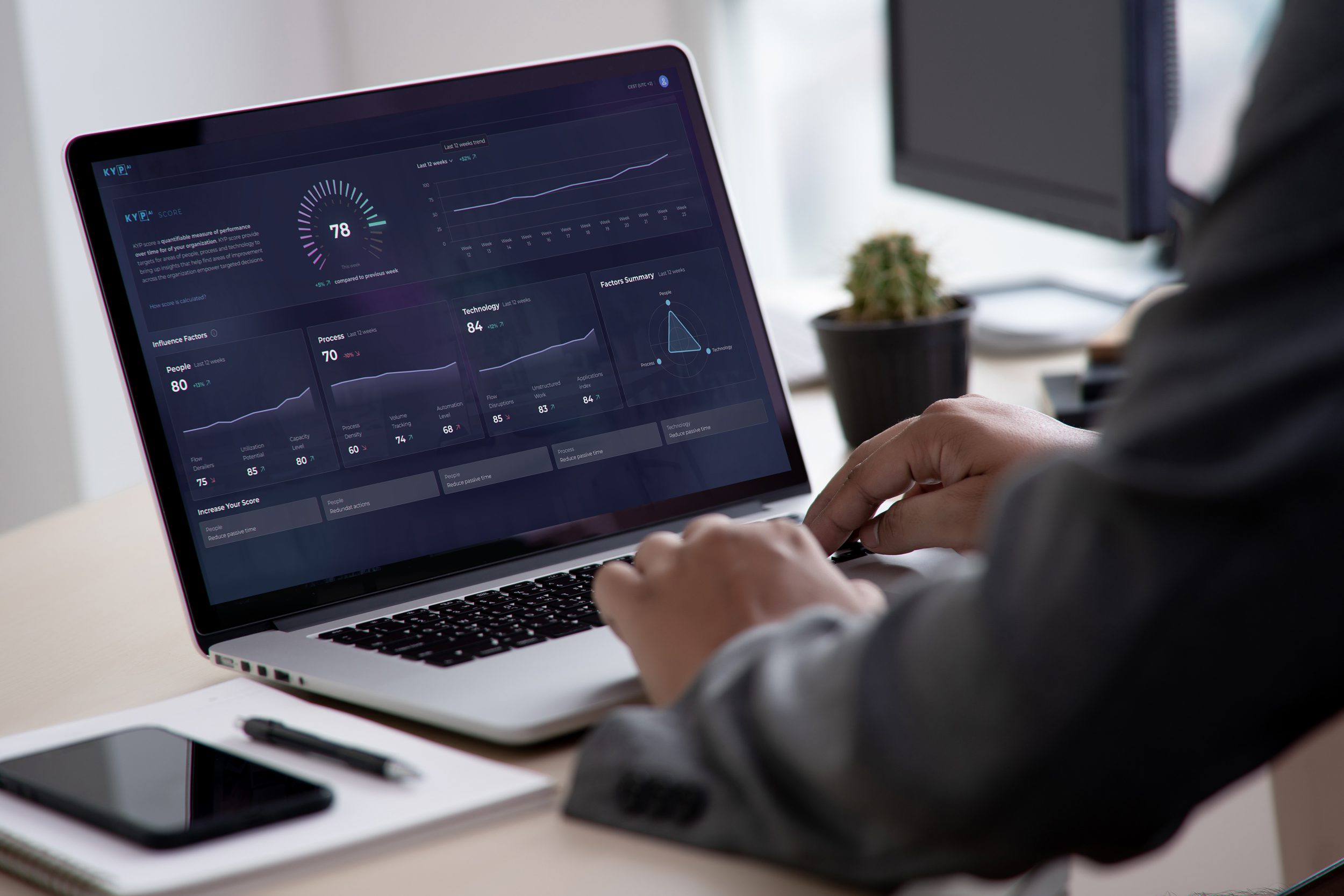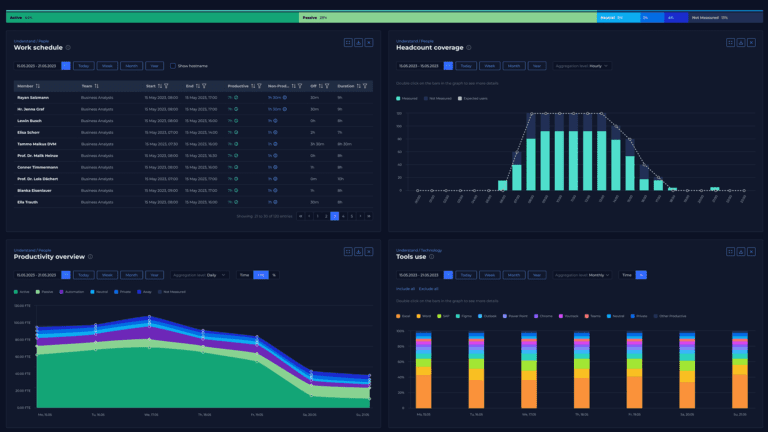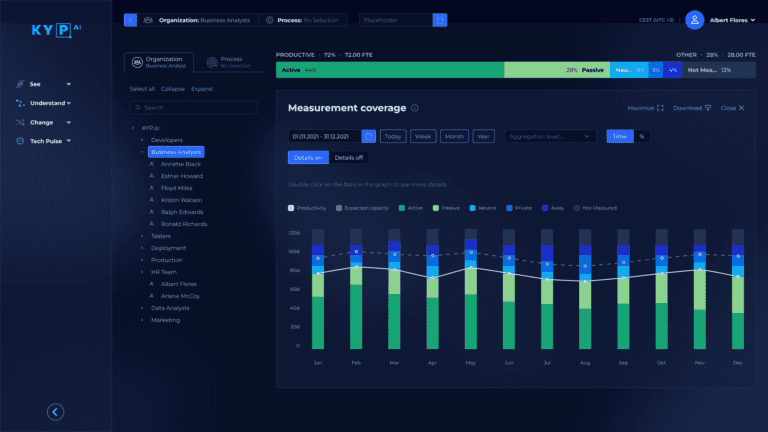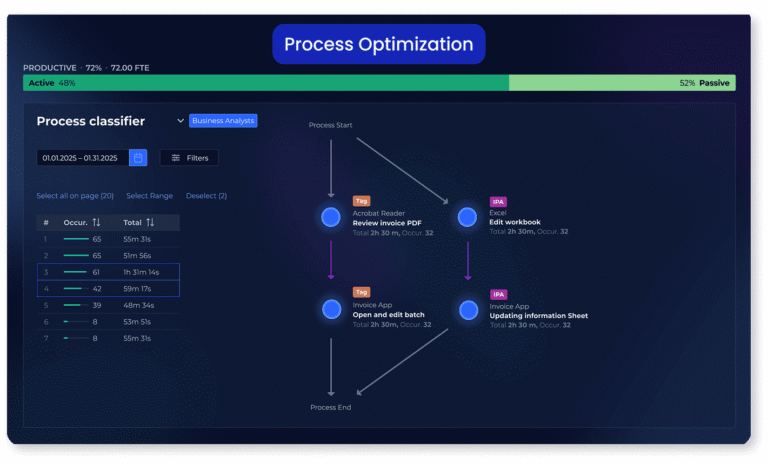The new wave of Gen AI is expanding process improvement examples that deliver continuous value. Even if showing return on value is a relentless challenge for business analysts and continuous improvement executives, the following process improvement examples unpack how leading companies are integrating new optimizations at scale.
How is process improvement shifting from return on investment to return on value?
If you are leading strategic business initiatives, you may feel pressure to use Generative AI, automate processes, and constantly improve. Over the last few years, we’ve seen a fundamental shift from ROI to ROV. Process improvement examples are no longer limited to one off optimizations. Instead, the expectation is to drive continuous value across the business.
Getting the data you need to improve
With the shift to ROV, you must focus on process improvements that yield both immediate and long-term benefits. Return on Value is not just about the financial gains that help the organization grow, but rather process improvements that span across different departments with different examples of success.
Still, many of us are spending 70% of time integrating data sources, which will limit us to incremental improvements in efficiency, productivity, and processes. A more automated approach to managing data integration tasks can achieve efficiency, productivity, and process improvement.

Challenges with today’s process improvement examples:
- Reports look backwards, telling you what already happened
- Predictive tools tell you what is likely to happen
- Real-time performance and KPI tracking requires manually piecing together different data sources into the format and view that you need to be successful
Demonstrating ROV requires both a forward-thinking approach and the right tools and resources to make it happen. Moving beyond traditional methods and embracing innovative solutions that can provide live performance visibility and intelligent insights is essential.
Process Improvement Example: Driving automation with chatbots better data
A food delivery service was challenged with unprecedented demand on their support team. Like many of us would, the business process team named chatbots as a potential solution. They assumed that chatbots could help reduce the need for tier one and two support escalations.
However, ‘trouble-shooting chatbots’ did not yield the results that they expected. How could this be? Doesn’t automation help increase productivity? In this case, chat bots were causing longer wait times, more escalations, and lower customer satisfaction.
With KYP.ai desktop agents, they quickly saw how they could improve their employees, procedures, and technology. Using Productivity 360, they could capture, diagnose, and improve performance using our actionable insights.
By harnessing tools that prioritize tasks based on their potential impact and track progress in real-time, organizations can make data-driven decisions that align with their strategic goals.
They found optimizations including:
- People utilization: customers were only spending only 5% of their time with chatbots. The plan to solve problems faster ended up making it more difficult for employees to help customers. Employees had to read many chat messages before being able to help.
- Customer feedback showed that the support agents were overly friendly in their language. These positive intentions did not meet the customer’s satisfaction for a support interaction. Further, they were unable to decide employee count for shifts, causing wasted resources.
Every company faces unique challenges. However, at KYP.ai, we notice that many companies rush into a solution without first gathering the necessary data.
“KYP.ai helps us to rapidly understand our processes and how these balance with people and technology dimensions. Their automatically generated, data-driven improvement recommendations help us to generate the fastest possible ROI.” – Rangaraj Sriramulu, SVP Digital Transformation at Alorica and KYP.ai customer
Organizations can improve decision-making by using tools that prioritize tasks based on their impact. By tracking progress in real-time, organizations can achieve strategic goals. Additionally, the adoption of Generative AI technologies promises to automate the mundane, allowing leaders to focus on high-value activities.
Preparing for this change requires being open to redefining the concept of ROI for your organization. It also means being ready to measure success using new methods.
Process improvement example: Company tech suite resourcing
A recent study by McKinsey found that generative AI could bring $2.6 trillion (about $8,000 per person in the US) to $4.4 trillion (about $14,000 per person in the US) in value to organizations annually. Rolling out technology must be purposeful. While organizations may be learning best practices as they go, there are techniques available to help ensure greater success.
Hollard is a leading insurance company with over four million members. They aimed to improve the efficiency of their services team by reducing tedious tasks. They wanted to use KYP.ai to understand optimal resource allocation.
- Who in the organization needs access to software?
- Where can we reduce equipment costs?
- Where are companies currently paying for more computing power than necessary?
- Which licenses are not being used?
Hollard uses Tech Pulse from the Productivity 360 platform to prioritize projects based on their potential impact. They gathered hardware data and process-related information. IT analysts, business process analysts, and continuous improvement teams use this information for more informed decisions.
Now, Hollard considers KYP to be an indispensable lever for strategic planning. By incorporating added notification features, we can encourage end-users to use applications and IT equipment more efficiently.
Companies can enhance productivity while also fostering a culture of innovation. Tackling low productivity rates helps Hollard understand the most productive employee working locations. This helps with employee satisfaction and keeps their competitive edge.
Aligning on your data strategy is a critical piece to improve your business processes across the organization. For example, this report by KYP dives deeper into Generative AI ROI specifically with CoPilot.

Process optimization example: GenAI Identification
GenAI identification uses algorithms and artificial intelligence for business optimization. This approach involves deploying AI systems that can learn, adapt, and make decisions with minimal human intervention. By analyzing vast datasets, GenAI systems find patterns and correlations that would be impossible for humans to detect unaided.
This level of analyzing is instrumental in uncovering optimization opportunities across various business processes, from supply chain management to customer service. GenAI has the ability to predict potential issues and recommend preventive actions, helping businesses to be proactive rather than reactive.
By studying GenAI’s mechanics, we can see that these smart systems are not just tools. They also act as partners in boosting business growth and operational success.

KYP.ai leverages data models at scale to pinpoint opportunities where Gen AI can have a significant impact on optimizing specific processes and tasks. This approach identifies areas for automation, freeing your team from mundane work, ultimately saving time, budget, and boosting your organization’s productivity.
Our discovery engine shows automation opportunities for both RPA (Robotic Process Automation) (structured and rule-based transactions) as well as IPA (interpretation and unstructured text) and calculates the automation potential. For example, a global BPO center found where to scale GenAI for a key financial client. Further, it provided scalable prioritization across the business.
Transforming your business requires a holistic view of the people, process, and technology trifecta. Software that analyzes your entire data ecosystem in a 360-degree view holds the key, regardless of whether you lead a shared services team or focus on day-to-day optimization. This includes analyzing how people interact with technology, its performance, and the gap between intended and actual process execution.
Concluding thoughts
We’ve all heard the hype and promises of AI before, and it can be difficult to decipher facts from vision. This transition introduces a new era where data flows seamlessly, and insights are derived with ease, leading to informed decisions and strategic actions. Gone are the days of compiling reports by hand; today’s tools capture and analyze data in real-time, supporting a proactive approach to business challenges.
As companies adopt these automated systems, they see a significant increase in productivity and a reduction in errors. By automating routine processes, employees are empowered to dedicate their time to creative and strategic endeavors that drive the business forward. This transition is not just about adopting technology, but rather embracing a culture of continuous improvement and innovation.
If you are starting out on your process improvement journey and considering Generative AI, you can book a free consultation with the KYP team or view this article where Gartner unpacks techniques to ensure a smooth rollout.
Discover Your Productivity Potential – Book a Demo Today
Book Demo








